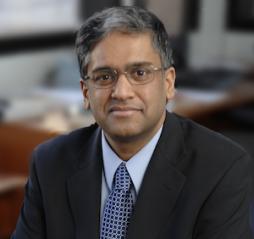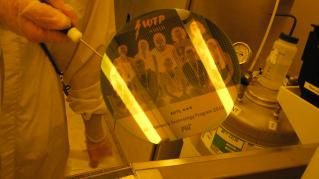Contribute
| Lokvani Talks To Anantha Chandrakasan |
Ranjani Saigal
07/06/2011
Professor Anantha Chandrakasan has recently been appointed as the Head of the prestigious Departmet of Electrical Engineering and Computer Science (EECS) at MIT. Chandrakasan will take over the role previously held by Eric Grimson, who was named MIT's chancellor in February. The EECS Department Head before that, Prof. Rafael Reif now serves as the MIT Provost. EECS is the largest academic department at MIT; nearly 30 percent of undergraduates major in the department's programs.
Prof. Chandrakasan's PhD thesis work established him as a visionary researcher. "His thesis work was a revolutionary innovation", says Dr. Dennis Buss, Chief Scientist at Texas Instruments. "His student presentation in Feb 1994 at the IEEE ISSCC (International Solid-State Circuits Conference), highlighted a chipset for a low-power multimedia terminal (the InfoPad), that consumed less that 5 mW while supporting a variety of functions including full motion video decoding. The presentation drew such large crowds that for the very first time the ISSCC asked that he repeat his presentation." Dennis considers himself to be fortunate to have been present at that talk. Chandrakasan now serves as the Conference Chair of ISSCC, which is regarded as the “Chip Olympics†and the premier forum for presenting advances in solid-state circuits and integrated systems-on-a-chip. “Another testimony to the importance of Prof. Chadrakasan’s work on ultra-low-power electronics is the fact that his IEEE Journal of Solid-State Circuits article (A. Chandrakasan, S. Sheng and R. Brodersen, “Low Power Digital CMOS Designâ€; IEEE JSSC, April 1992.), has the second highest number of citations in the history of the IEEE JSSC†says Buss.
Like any revolutionary research his work was initially greeted with skepticism. “When I was working my thesis, logic speed and silicon implementation area were the primary design metrics. Our work introduced energy as a key design metric. When we first presented our low-power design ideas at conferences, they were met with significant skepticism. This included for example, the notion that the power supply voltage is a "free variable†and using more silicon area (parallelism) for lower power consumption. The presentation at ISSCC 1994, demonstrated the concepts on a low-power chipset for the InfoPad multimedia terminal, using dramatically lower power consumption compared equivalent state-of-the-art circuits.†When the chips worked, Prof. Chandrakasan knew the approach would have an impact. Today, the notion of parallelism to reduce energy consumption is widely used in digital microprocessors.
Chandrakasan has served as the Director of MIT’s Microsystems Technology Laboratories for the past five years. What excites him most about his research? “Our goal is to have a broad impact on energy efficient electronic systems – whether it be getting biomedical devices to run off of body heat or solar energy harvesting in rural areas where charging devices is an issue. At MIT we have the opportunity to collaborate with extremely talented researchers across disciplines.†His group also has strong collaboration with industry. Prof. Chandrakasan and his students recently collaborated with engineers at Texas Instruments to demonstrate a low-power Smartphone application processor in state-of-the-art 28nm CMOS technology. This work implemented was highlighted at ISSCC 2011. “We also have the opportunity to collaborate with world-class hospitals in the Boston area. Boston has the potential to become the Silicon Valley of Medical Electronic Systems,†says Prof. Chandrakasan. Prof. Chandrakasan strongly believes that it will be possible to spin off large number of startups in the Boston area related to health monitoring devices; this has the potential to create a new economic boom while improving overall health care.
What inspired this extraordinary researcher to take on an administrative post in the department? “Teaching and research are rather intertwined and as the Department Head I would have the opportunity to influence the direction of both in Electrical Engineering and Computer science.†Prof. Chandrakasan is passionate about teaching and received a prestigious 2007 Eta Kappa Nu Undergraduate Guide, ‘Excellence in EECS Teaching’ Award for his contributions to undergraduate education.
Chandrakasan has planned a number of exciting initiatives as the Department Head of EECS. “One of the focus areas is to emphasize research at the undergraduate level. We have a strong undergraduate research program (UROP) and my goal is to get more EECS undergraduates in our department excited about publication worthy research. I am excited to help our students achieve their potential and create a lasting impact on societal problems. I would like to emphasize the value of inter-disciplinary collaboration not only blending together EE and CS, but also collaboration with other departments in engineering and science. My goal is to build on top of the exciting initiatives already in place in EECSâ€.
Chandrakasan has great interest to bring technology to the K-12 curriculum and motivate the young to take up a career in technology. “Getting children excited about science and technology at early age is criticalâ€. MTL hosts a micro-fabrication module as part of the MIT Women's Technology Program (a program for high-school girls). "The women in the program were excited to observe the use of clean rooms used to fabricate chips. I hope many of them will consider a career in this field".
Chandrakasan came to the United States from India when he was 15 years old. His mother was a researcher and served as a source of inspiration to him as he took on a career in academia. He went to school at the University of California at Berkeley where he received his B.S., M.S. and PhD degrees. Despite being a researcher whose work is impacting the world in a significant manner and holding a very important position, Chandrakasan’s mild mannered, humble and down to earth persona makes him very accessible to students while inspiring them to do great work.
Lokvani salutes this great Indian American and looks forward to seeing the impact of his work in the years to come.
Biography:
Anantha P. Chandrakasan received the B.S, M.S. and Ph.D. degrees in Electrical Engineering and Computer Sciences from the University of California, Berkeley, in 1989, 1990, and 1994 respectively. Since September 1994, he has been with the Massachusetts Institute of Technology, Cambridge, where he is currently the Joseph F. and Nancy P. Keithley Professor of Electrical Engineering.
He has been the co-recipient of several awards including the 1993 IEEE Communications Society Best Tutorial Paper Award, the IEEE Electron Devices Society 1997 Paul Rappaport Award for the Best Paper in an EDS publication during 1997, the 1999 DAC Design Contest Award, the 2004 DAC/ISSCC Student-Design-Contest Award, the 2007 IEEE ISSCC Beatrice Winner Award for Editorial Excellence, and the IEEE ISSCC Jack Kilby Award for Outstanding Student Paper (2007, 2008, 2009). He received the 2009 Semiconductor Industry Association (SIA) University Researcher Award.
His research interests include micro-power digital and mixed-signal integrated circuit design, wireless microsensor system design, portable multimedia devices, and energy efficient radios. He is a co-author of Low Power Digital CMOS Design (Kluwer Academic Publishers, 1995), Digital Integrated Circuits (Pearson Prentice-Hall, 2003, 2nd edition), and Sub-threshold Design for Ultra-Low Power Systems (Springer 2006). He is also a co-editor of Low Power CMOS Design (IEEE Press, 1998), Design of High-Performance Microprocessor Circuits (IEEE Press, 2000), and Leakage in Nanometer CMOS Technologies (Springer, 2005).
He has served as the Technical Program Co-Chair for the 1997 International Symposium on Low-Power Electronics and Design (ISLPED), 1998 VLSI Design, and the 1998 IEEE Workshop on Signal-Processing Systems. He was the Signal_Processing Sub-Committee Chair for ISSCC 1999-2001, the Program Vice-Chair for ISSCC 2002, the Program Chair for ISSCC 2003, the Technology-Directions Sub-Committee Chair for ISSCC 2004-2009, and the Conference Chair for ISSCC 2010 and 2011. He will be conference chair for 2012. He was an Associate Editor for the IEEE Journal of Solid-State Circuits from 1998 to 2001. He served on SSCS AdCom from 2000 to 2007; and he was the Meetings Committee Chair from 2004 to 2007. Since 2006, he has served as the Director of the MIT Microystems Technology Laboratories (MTL) which has over 700 users.
You may also access this article through our web-site http://www.lokvani.com/


Source - Micronotes